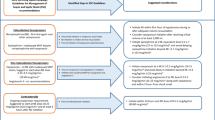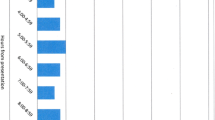Abstract
Objective
Vasopressin (AVP) response has been reported to be inappropriately low in adult established septic shock. We studied admission AVP levels in children with meningococcal septic shock (MSS).
Patients and methods
All children with meningococcal infection admitted to our PICU between May 2001 and August 2002 were classified as MSS (persistent hypotension despite fluid therapy, with perfusion abnormalities and the need for vasoactive drug infusion for at least 24 h or until death), or meningococal infection without shock (fever and purpura, with or without meningitis). Blood samples were collected at admission and AVP levels were subsequently determined using Nichols Institute Diagnostics vasopressin assay. Eighteen of 19 children with MSS (7 deaths) and 15 without shock (no death) were included.
Results
In children with MSS median admission AVP level was 41.6 pg/ml (1.4–498.9) and in those without 3.3 pg/ml (1.6–63.8). In children with MSS the AVP level was not correlated with duration of shock and fluid expansion prior to AVP sampling, or with age-adjusted blood pressure and natremia at the time of blood sampling. AVP levels were higher in nonsurvivors, but not significantly so. Only one nonsurvivor had an admission AVP level below 30 pg/ml.
Conclusions
In our children with established MSS who died the admission AVP level Δ were not inappropriately low. Further studies including serial AVP level assessments are needed before concluding that AVP administration is of little interest in children with MSS.


Similar content being viewed by others
References
Landry DW, Oliver JA (2001) The pathogenesis of vasodilatory shock. N Engl J Med 345:588–595
Holmes CL, Patel BM, Russell JA, Walley KR (2001) Physiology of vasopressin relevant to management of septic shock. Chest 120:989–1002
Aiura K, Ueda M, Endo M, Kitajima M (1995) Circulating concentrations and physiologic role of atrial natriuretic peptide during endotoxic shock in the rat. Crit Care Med 23:1898–1906
Giusti-Paiva A, De Castro M, Antunes-Rodrigues J, Carnio EC (2002) Inducible nitric oxide synthase pathway in the central nervous system and vasopressin release during experimental septic shock. Crit Care Med 30:1306–1310
Landry DW, Levin HR, Gallant EM, Ashton RC, Seo S, D'Alessandro D, Oz MC, Oliver JA (1997) Vasopressin deficiency contributes to the vasodilation of septic shock. Circulation 95:1122–1125
Tsuneyoshi I, Yamada H, Kakihana Y, Nakamura M, Nakano Y, Boyle WA (2001) Hemodynamic and metabolic effects of low-dose vasopressin infusions in vasodilatory septic shock. Crit Care Med 29:487–493
Landry DW, Levin HR, Gallant EM, Seo S, D'Alessandro D, Oz MC, Oliver JA (1997) Vasopressin pressor hypersensitivity in vasodilatory septic shock. Crit Care Med 25:1279–1282
Malay MB, Ashton RC, Landry DW, Townsend RN (1999) Low-dose vasopressin in the treatment of vasodilatory septic shock. J Trauma 47:699–705
Holmes CL, Walley KR, Chittock DR, Lehman T, Russell JA (2001) The effects of vasopressin on hemodynamics and renal function in severe septic shock: a case series. Intensive Care Med 27:1416–1421
Dünser MW, Mayr AJ, Ulmer H, Ritsch N, Knotzer H, Pajk W, Luckner G, Mutz NJ, Hasibeder WR (2001) The effects of vasopressin on systemic hemodynamics in catecholamine-resistant septic and postcardiotomy shock: a retrospective analysis. Anesth Analg 93:7–13
O'Brien A, Clapp L, Singer M (2002) Terlipressin for norepinephrine-resistant septic shock. Lancet 359:1209–1210
Patel BM, Chittock DR, Russell JA, Walley KR (2002) Beneficial effects of short-term vasopressin infusion during severe septic shock. Anesthesiology 96:576–582
Ryan DW, Kilner AJ (2002) What about vasopressin? Intensive Care Med 28:810–811
Starc TJ, Rosenzweig EB, Landry DW, Jayakumar A, Smerling AJ, Zucker HA, Trinkaus PM, Biagas KV, Nares MA, Jerome EH, Koumbourlis AC, Schleien CL (2000) Emergency use of vasopressin in children with vasodilatory shock due to sepsis or after bypass. Crit Care Med 28:A71
Rosenzweig EB, Starc TJ, Chen JM, Cullinane S, Timchak DM, Gersony WM, Landry DW, Galantowicz ME (1999) Intravenous arginine-vasopressin in children with vasodilatory shock after cardiac surgery. Circulation 100 [Suppl II]:II-182–II-186
Choi SJ, Jeffries HE, Willis BL, Newth CJ, Bart RD, Wetzel RC (2003) Vaspressin deficiency in pediatric septic shock. Pediatr Crit Care Med 4:141 (A5)
Martinot A, Leclerc F, Cremer R, Leteurtre S, Fourier C, Hue V (1997) Sepsis in neonates and children: definitions, epidemiology and outcome. Pediatr Emerg Care 13:277–281
Bone RC, Balk RA, Cerra FB, Dellinger RP, Fein AM, Knaus WA, Schein RM, Sibbald WJ (1992) Definitions for sepsis and organ failure and guidelines for the use of innovative therapies in sepsis. The ACCP/SCCM Consensus Conference Committee. American College of Chest Physicians/Society of Critical Care Medicine. Chest 101:1644–1655
Fourrier F, Bricard H, Cohen Y, Daoud P, Guidet B, Huet F, Laterre PF, Marquette CH, Schaller MD, Sollet JP, Tamion F (2000) Corticothérapie au cours du choc septique et du syndrome de détresse respiratoire aiguë. XXème Conférence de consensus en réanimation et médecine d'urgence. Reanim Urgences 9:597–603
Dibley MJ, Staehling N, Nieburg P, Trowbridge FL (1987) Interpretation of z score anthropometric indicators derived from the international growth reference. Am J Clin Nutr 46:749–762
Task Force on blood pressure control in children (1987) Report of the second Task Force on blood pressure control in children. Pediatrics 79:1–25
van Doesburg NH, Guimond JG, Mercier JC, Lacroix J, Gauthier M (1994) Surveillance: généralités. In: Lacroix J, Gauthier M, Beaufils F (eds) Urgences et soins intensifs pédiatriques. Les Presses de l'université de Montreal, Doin, Paris, pp 49–78
Pollack MM, Ruttimann UE, Getson PR (1988) Pediatric risk of mortality (PRISM) score. Crit Care Med 16:1110–1116
De Groof F, Joosten KFM, Janssen JAMJL, De Kleijn ED, Hazelzet JA, Hop WCJ, Uitterlinden P, Van Doorn J, Hokken-Koelega ACS (2002) Acute stress response in children with meningococcal sepsis: important differences in the growth hormone /insulin-like growth factor I axis between nonsurvivors and survivors. J Clin Endocrinol Metab 87:3118–3124
Van der Kaay DCM, De Kleijn ED, De Rijke YB, Hop WCJ, De Groot R, Hazelzet JA (2002) Procalcitonin as a prognostic marker in meningococcal disease. Intensive Care Med 28:1606–1612
Butt W (2001) Septic shock. Pediatr Clin North Am 48:601–625
Carcillo JA, Fields AI, Task force committee members (2002) Clinical practice parameters for hemodynamic support of pediatric and neonatal patients in septic shock. Crit Care Med 30:1365–1378
Boykin J De Torrente A, Erickson A, Roberston G, Schriver RW (1978) Role of plasma vasopressin in impaired water excretion of glucocorticoid deficiency. J Clin Invest 62:738–744
Papanek PE, Sladek CD, Raff H (1997) Corticosterone inhibition of osmotically stimulated vasopressin from hypothalamic-neurohypophysial explants. Am J Physiol 272:R158–R162
Liedel J, Meadow W, Nachman J, Koogler T, Kahana MD (2002) Use of vasopressin in refractory hypotension in children with vadilatory shock: five cases and a review of the literature. Pediatr Crit Care Med 3:15–18
Scharte M, Meyer J, Van Aken H, Bone HG (2001) Hemodynamic effects of terlipressin (a synthetic analog of vasopressin) in healthy and endotoxemic sheep. Crit Care Med 29:1756–1760
Kahn JM, Kress JP, Hall JB (2002) Skin necrosis after extravasation of low-dose vasopressin administered for septic shock. Crit Care Med 30:1899–1901
Westphal M, Bone HG, Van Aken H, Sielenkämper AW (2002) Terlipressin for haemodynamic support in septic patients: a double-edged sword? Lancet 360:1250–1251
Asfar P (2003) Terlipressin in chronic hyperdynamic endotoxic shock: is it safe? Intensive Care Med 29:154–155
Author information
Authors and Affiliations
Corresponding author
Rights and permissions
About this article
Cite this article
Leclerc, F., Walter-Nicolet, E., Leteurtre, S. et al. Admission plasma vasopressin levels in children with meningococcal septic shock. Intensive Care Med 29, 1339–1344 (2003). https://doi.org/10.1007/s00134-003-1868-y
Received:
Accepted:
Published:
Issue Date:
DOI: https://doi.org/10.1007/s00134-003-1868-y




